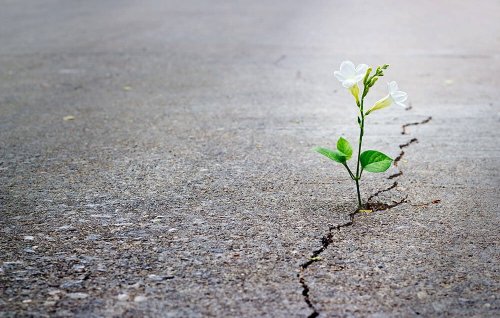Wabi-Sabi: The Beauty of Imperfection

Wabi-sabi is a Zen concept that refers to the ability to see the beauty in imperfections. It’s an Eastern philosophy that’s a tool for personal development that can help people lead happy and peaceful lives.
In fact, wabi-sabi is the art of the harmony and wellness of imperfection. It’s the ability to find beauty in the simplest of things. Leonard Koren, author of Wabi-Sabi for Artists, Designers, Poets & Philosophers, claims that wabi-sabi is all about traditional Japanese beauty, which pursues imperfect or incomplete things. In other words, wabi-sabi is the acceptance of the unconventional.
But it’s also worth noting that wabi-sabi isn’t only about external factors; it’s also about deeper concepts such as humbleness, simplicity, solitude, or even abandonment. It’s a way of living at peace with yourself and your surroundings.
The origins of wabi-sabi
Wabi-sabi is associated to the Buddhist concept of tri laksana, or the three marks of existence, which states that everything that happens in nature is subject to three fundamental characteristics: impermanence, suffering, and non-self.
Although you may think that wabi-sabi is an Eastern aesthetic pattern that compares to Western beauty standards, it actually isn’t.

In fact, ‘wabi’ means living in moderation and avoiding any kind of luxury. It’s exactly the opposite of extravagance and wasteful behavior. The word ‘sabi’, on the other hand, means serenity and tranquility that come with age or intellectual maturity.
Therefore, wabi-sabi highlights the beauty of imperfections and the greatness of simple things, without disregarding the decadent aspects of the world, where sadness and desolation merge in absolute melancholy.
Kintsukuroi: Damage makes an object stronger and more beautiful
You could even associate wabi-sabi to the Japanese technique kintsukuroi, which consists of repairing broken objects by filling in their cracks with gold. This way, the object becomes more beautiful and stronger than it was before.
In addition, this concept can be applied to a broken soul, one that has suffered. However, what kintsukuroi’s philosophy teaches is that difficult times can be a great opportunity to become a stronger and more beautiful person, with scars to remind you that you’re capable of restoring yourself thanks to your resilience in tough times.
Wabi-sabi and psychology
From a psychological standpoint, resilience is the ability to face difficult times and come out stronger from them. A resilient person discovers inner resources that help them get back up after a traumatic experience.
So, for resilient people, a problem or a crisis is a challenge, a chance to grow and develop. They use pain as fuel to reach new goals, move forward, and achieve balance in life.

Finding the way out in the labyrinth of life and being at peace with yourself and with others are very important aspects.
Wabi-sabi erases all possible limitations as long as you believe in yourself. It makes you achieve anything that seemed impossible before through your own hard work. This ability is especially useful in tough times, as you won’t get easily overwhelmed by your problems and you’ll be able to set new goals that you truly believe in.
Learn to see the beauty in every little thing to be able to enjoy life.
Wabi-sabi is a Zen concept that refers to the ability to see the beauty in imperfections. It’s an Eastern philosophy that’s a tool for personal development that can help people lead happy and peaceful lives.
In fact, wabi-sabi is the art of the harmony and wellness of imperfection. It’s the ability to find beauty in the simplest of things. Leonard Koren, author of Wabi-Sabi for Artists, Designers, Poets & Philosophers, claims that wabi-sabi is all about traditional Japanese beauty, which pursues imperfect or incomplete things. In other words, wabi-sabi is the acceptance of the unconventional.
But it’s also worth noting that wabi-sabi isn’t only about external factors; it’s also about deeper concepts such as humbleness, simplicity, solitude, or even abandonment. It’s a way of living at peace with yourself and your surroundings.
The origins of wabi-sabi
Wabi-sabi is associated to the Buddhist concept of tri laksana, or the three marks of existence, which states that everything that happens in nature is subject to three fundamental characteristics: impermanence, suffering, and non-self.
Although you may think that wabi-sabi is an Eastern aesthetic pattern that compares to Western beauty standards, it actually isn’t.

In fact, ‘wabi’ means living in moderation and avoiding any kind of luxury. It’s exactly the opposite of extravagance and wasteful behavior. The word ‘sabi’, on the other hand, means serenity and tranquility that come with age or intellectual maturity.
Therefore, wabi-sabi highlights the beauty of imperfections and the greatness of simple things, without disregarding the decadent aspects of the world, where sadness and desolation merge in absolute melancholy.
Kintsukuroi: Damage makes an object stronger and more beautiful
You could even associate wabi-sabi to the Japanese technique kintsukuroi, which consists of repairing broken objects by filling in their cracks with gold. This way, the object becomes more beautiful and stronger than it was before.
In addition, this concept can be applied to a broken soul, one that has suffered. However, what kintsukuroi’s philosophy teaches is that difficult times can be a great opportunity to become a stronger and more beautiful person, with scars to remind you that you’re capable of restoring yourself thanks to your resilience in tough times.
Wabi-sabi and psychology
From a psychological standpoint, resilience is the ability to face difficult times and come out stronger from them. A resilient person discovers inner resources that help them get back up after a traumatic experience.
So, for resilient people, a problem or a crisis is a challenge, a chance to grow and develop. They use pain as fuel to reach new goals, move forward, and achieve balance in life.

Finding the way out in the labyrinth of life and being at peace with yourself and with others are very important aspects.
Wabi-sabi erases all possible limitations as long as you believe in yourself. It makes you achieve anything that seemed impossible before through your own hard work. This ability is especially useful in tough times, as you won’t get easily overwhelmed by your problems and you’ll be able to set new goals that you truly believe in.
Learn to see the beauty in every little thing to be able to enjoy life.
This text is provided for informational purposes only and does not replace consultation with a professional. If in doubt, consult your specialist.







